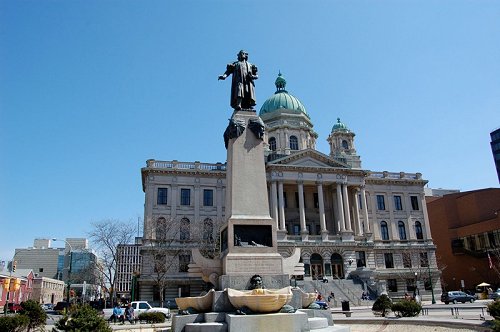
 Syracuse, New York
Syracuse, New YorkSource: https://commons.wikimedia.org/wiki/File:Syracuse_skyline.jpg
Author: Gizzakk

Syracuse is the fifth most populous city in New York. Located near the center of New York State, Syracuse has place an important role at the crossroad of important transportation lines for New York through the ages. The modern city covers 26.6 sq mi (66.4 sq km) and has a population of 145,000 (2011 estimate), within a metropolitan area of 745,000 people.
Syracuse is a manjor convention site. The annual Great New York State Fair is held here at the Empire Expo Center. Various other conventions are held at the downtown convention complex. It is also home to Syracuse University, a prominent research university in the United States.
 Syracuse Courthouse
Syracuse CourthouseSource: https://commons.wikimedia.org/wiki/File:Syracuse_Courthouse.jpg
Author: Chloe Clay

Syracuse was named after the city of the same name (or Siracusa in Italian) in Sicily, Italy. Until the arrival of Europeans, the area was inhabited by Native Americans of various tribes including Mohawks, Senecas, Onondagas, Oneidas and Cayugas. The French were the first European forces to arrive in the area. French navigator Samuel de Champlain launched an assault on the Oneidas in 1615, with help from other Native American tribes, the Huron and Algonquian Indians.
The British began taking an interest in the Syracuse area in the early 18th century. They befriended rival Native American tribes and acquired land in the area. The initial settlement of Syracuse itself was done somewhere in the late 18th century, at a site which was originally swampy ground. Various villages were established in the area under various names between 1793 and 1824. The village of Syracuse was laid out in 1819. It was incorporated as a city in 1847. The main industry of the area back then was salt production.
 St Paul's Armenian Apostolic Church, Syracuse
St Paul's Armenian Apostolic Church, SyracuseSource: https://commons.wikimedia.org/wiki/File:St_Paul_Armenian.jpg
Author: Crazyale

The completion of the Erie Canal in 1825 brought about an increase in the demand of salt, fueling the local economy of Syracuse. Due to its geographical location, it was also a meeting point for major waterways, railroads and later interstate highways.
Syracuse experiences a humid continental climate. The warmest month is July, when the average temperature breaches 80°F. The coldest month is January, when the average low drops to 12°F.
Visiting Syracuse, New York
Syracuse is the intersected by Interstate 81 and Interstate 90. The I-81 runs north south, connecting the city with the Canadian border to the north, and with Scranton to the south. The I-90 runs east-west, connecting it with Albany to the east and Rochester to the west.Places of Interest in Syracuse, New York
- Beaver Lake
- Carrier Dome
- Everson Museum
- Eric Canal Museum
- Green Lakes
- Museum of Science and Technology
- Oneida Lake
- Onondaga Lake Park
 Latest updates on Penang Travel Tips
Latest updates on Penang Travel Tips
About this website

Dear visitor, thank you so much for reading this page. My name is Timothy Tye and my hobby is to find out about places, write about them and share the information with you on this website. I have been writing this site since 5 January 2003. Originally (from 2003 until 2009, the site was called AsiaExplorers. I changed the name to Penang Travel Tips in 2009, even though I describe more than just Penang but everywhere I go (I often need to tell people that "Penang Travel Tips" is not just information about Penang, but information written in Penang), especially places in Malaysia and Singapore, and in all the years since 2003, I have described over 20,000 places.
While I try my best to provide you information as accurate as I can get it to be, I do apologize for any errors and for outdated information which I am unaware. Nevertheless, I hope that what I have described here will be useful to you.
To get to know me better, do follow me on Facebook!
Copyright © 2003-2025 Timothy Tye. All Rights Reserved.

 Go Back
Go Back